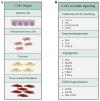Cancer-associated fibroblast cell surface markers as potential biomarkers or therapeutic targets in lung cancer
- PMID: 39403603
- PMCID: PMC11472577
- DOI: 10.20517/cdr.2024.55
Cancer-associated fibroblast cell surface markers as potential biomarkers or therapeutic targets in lung cancer
Abstract
Cancer-associated fibroblasts (CAFs) are the vital constituent of the tumor microenvironment, and in communication with other cells, they contribute to tumor progression and metastasis. Fibroblasts are the proposed origin of CAFs, which are mediated by pro-inflammatory cytokines and the recruitment of immune cells akin to wound healing. Although various studies have identified different subpopulations of CAFs in lung cancer, the heterogeneity of CAFs, particularly in lung cancer, and their potential as a therapeutic target remain largely unknown. Notwithstanding CAFs were previously thought to have predominantly tumor-promoting features, their pro- or anti-tumorigenic properties may depend on various conditions and cell origins. The absence of distinct markers to identify CAF subpopulations presents obstacles to the successful therapeutic targeting and treatment of CAFs in cancer. Human clinical and animal studies targeting CAFs have shown that targeting CAFs exacerbates the disease progression, suggesting that subpopulations of CAFs may exert opposing functions in cancer progression. Therefore, it is essential to pinpoint specific markers capable of characterizing these subpopulations and revealing their mechanisms of function. The cell-specific surface markers of CAFs will serve as an initial step in investigating precise CAF subpopulations and their role in diagnosing and targeting therapy against cancer-promoting CAF subsets in lung cancer.
Keywords: Fibroblasts; inflammation; lung cancer; targeted therapy; therapeutic markers.
© The Author(s) 2024.
Conflict of interest statement
All authors declared that there are no conflicts of interest.
Figures



Similar articles
-
Metabolic and Immunological Implications of MME+CAF-Mediated Hypoxia Signaling in Pancreatic Cancer Progression: Therapeutic Insights and Translational Opportunities.Biol Proced Online. 2024 Sep 28;26(1):29. doi: 10.1186/s12575-024-00254-1. Biol Proced Online. 2024. PMID: 39342097 Free PMC article.
-
Deciphering the temporal heterogeneity of cancer-associated fibroblast subpopulations in breast cancer.J Exp Clin Cancer Res. 2021 May 20;40(1):175. doi: 10.1186/s13046-021-01944-4. J Exp Clin Cancer Res. 2021. PMID: 34016130 Free PMC article.
-
Single-Cell Transcriptomic Analysis of Tumor-Derived Fibroblasts and Normal Tissue-Resident Fibroblasts Reveals Fibroblast Heterogeneity in Breast Cancer.Cancers (Basel). 2020 May 21;12(5):1307. doi: 10.3390/cancers12051307. Cancers (Basel). 2020. PMID: 32455670 Free PMC article.
-
Cancer-Associated Fibroblasts: Versatile Players in the Tumor Microenvironment.Cancers (Basel). 2020 Sep 17;12(9):2652. doi: 10.3390/cancers12092652. Cancers (Basel). 2020. PMID: 32957515 Free PMC article. Review.
-
Cancer-associated fibroblasts subtypes and role in invasion and metastasis of gastric cancer.Neoplasma. 2022 Dec;69(6):1277-1288. doi: 10.4149/neo_2022_220513N511. Epub 2022 Aug 30. Neoplasma. 2022. PMID: 36129833 Review.
Cited by
-
The immune microenvironment in endometrial carcinoma: mechanisms and therapeutic targeting.Front Immunol. 2025 Jul 17;16:1586315. doi: 10.3389/fimmu.2025.1586315. eCollection 2025. Front Immunol. 2025. PMID: 40746533 Free PMC article. Review.
References
Publication types
LinkOut - more resources
Full Text Sources
